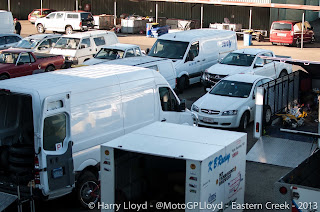Social media has become a huge part
of our lives, particularly if you are running a business. In many cases social
media sites and services such as Facebook, Twitter and Instagram provide an
excellent source of free marketing and exposure. In a clothing store I
overheard that 80% of their business came from Instagram. An amazing statistic
for a free service not even intended to be used as advertising.
These services not only provide
free exposure but also bring, or enhance, the personality of a business,
product or person. Dorna uses Twitter and Instagram to great effect with MotoGP,
not only is news posted there and links to videos on their website provided but
funny little things, like the Cal – Marquez Parc Ferme ‘incident’ are also posted. Not only does this give a chance to have these photos and
videos seen by a new audience, but small things like this show that even a big
company like Dorna has a sense of humor, making it seem friendly. And we all
like friends, right? Actions like this may seem small but go a long to keeping
current fans and improving the overall image of the brand, even with photos
like Cal’s and Marc’s that are a bit, questionable.
Considering all of this it’s a huge
surprise that a global series like World Superbike has almost no social media
presence. The name ‘WSBK’ on Instagram belongs to someone named ‘Wendy’ with
zero followers or photos. Furthermore the WSBK Twitter links mostly to race reports
and rider interviews, in text, on their website. Obviously there are some
photos of riders and paddock personalities doing silly things but overall it’s
a very dry affair.
The World Superbike championship
has a lot of problems on and off the track, but social media, or lack thereof,
seems a very simple thing to fix in the grand scheme of it all. But instead the
championship lags behind and struggles, confusing when WSBK and MotoGP are both
owned by Dorna now and one would assume they’d be able to apply a social media
strategy across two championships. Video content is almost drastically
different across the two championships, most likely a hold over from the days
of Infront’s ownership of WSBK.
With an emphasis on social media
and web content in general, video has become critical, especially in a sport
with chances for spectacular replays, like racing. MotoGP, despite a few flaws,
produces excellent video content, even excluding the season video pass. WSBK’s
website has none of this, their YouTube channel has some content but not nearly
as diverse as that of MotoGP. These videos also lack personality; they don’t
play up the relationships of riders or any characters or drama in WSBK. This
perhaps has to do with Eurosport having a significant hold on all the video content
produced for WSBK as a result of a deal with Infront Media.
The general branding and
presentation of the characters in the WSBK is lacking too. Many people who are
not die-hard fans complain of not being able to distinguish between riders and
teams in WSBK, especially with the majority of Kawasakis looking exactly the
same in WSBK and WSS. As in GP, it is often difficult to balance the wants of a
manufacturer, such as wanting to have their bikes green, with the needs of the
series and promotion. To become a bigger series you first have to act like one,
with all the extra flair and emphasis on characters and dramatic storylines.
Sykes’ championship loss by half a point last season has set up a great story
for this season, but there has been very little focus on it. Most races seem to
be produced individually as opposed to being thought of as an overall series.
Obviously a better and more diverse
web presence isn’t going to fix WSBK overnight, but it does highlight some of
the bigger problems. Smaller details have been overlooked and continue to be,
even when these small details are as essential as social media and web presence
in general. With crowds at record lows in many events and factories pulling out
left and right its time for change, not just with rules but how the series is
promoted as a whole. Promotion is a huge part of sporting events, especially
relatively small ones such as production motorcycle racing and the internet is
an easy and often even free way to help with this, but like many things, the
WSBK series has overlooked it.
